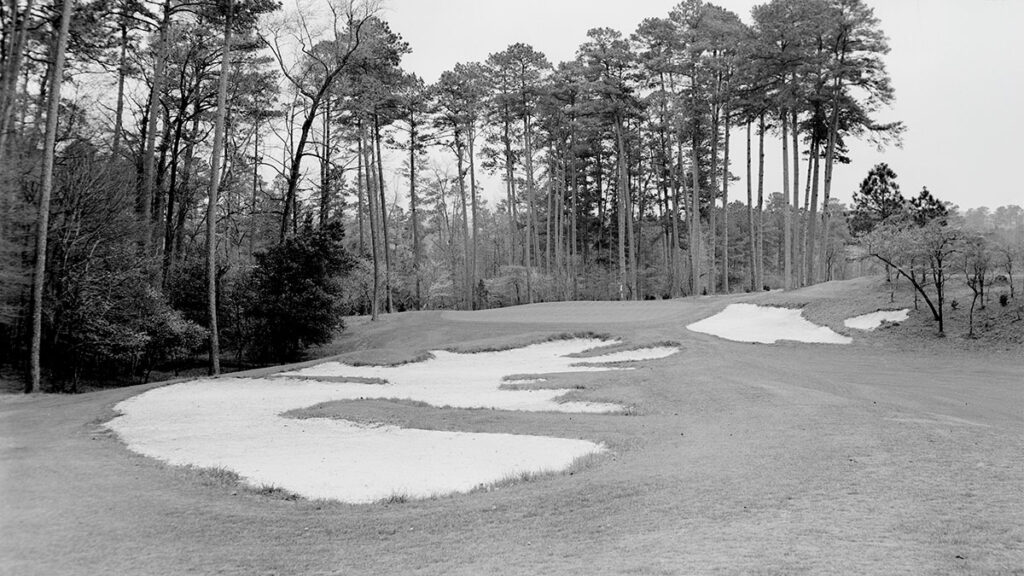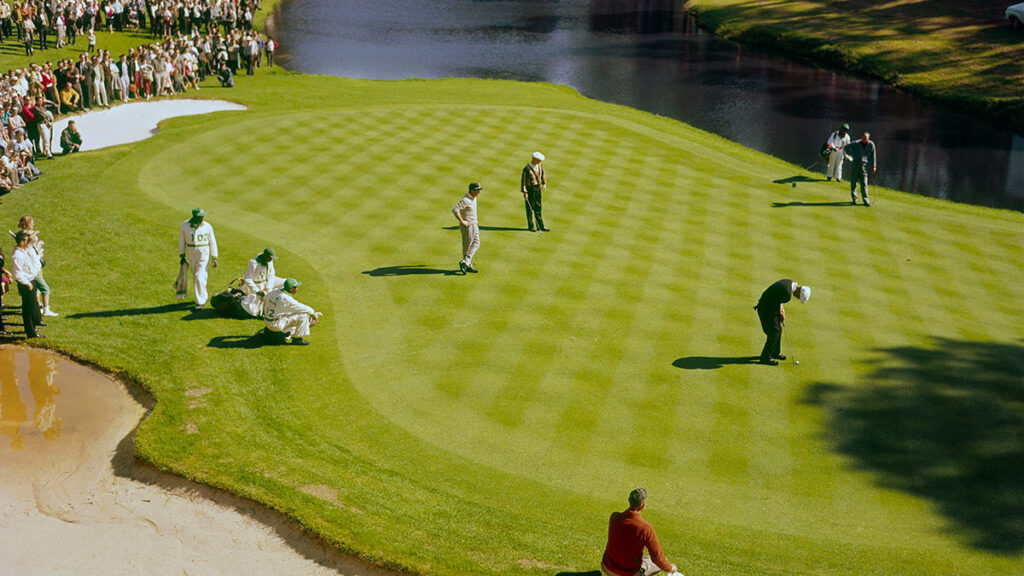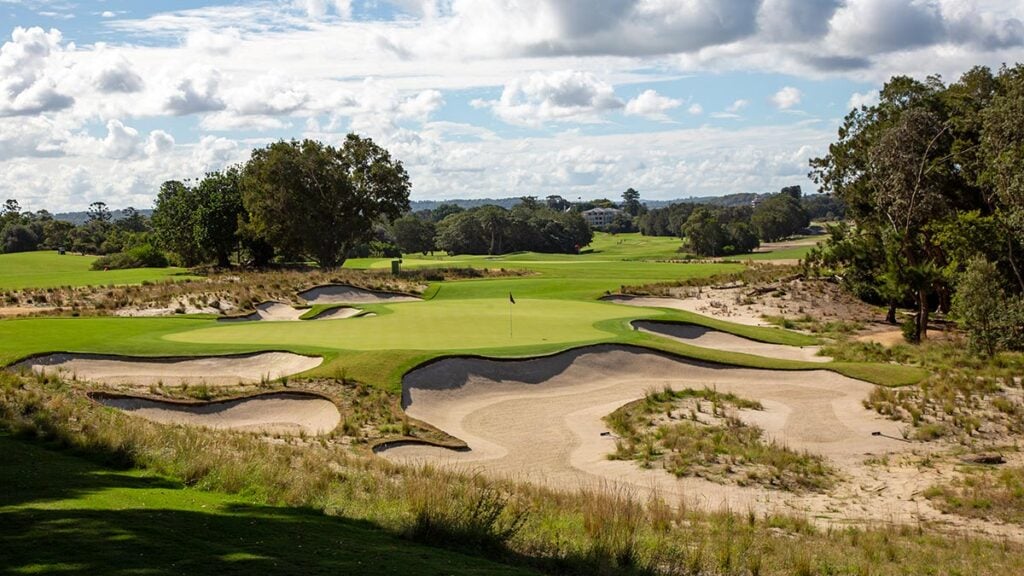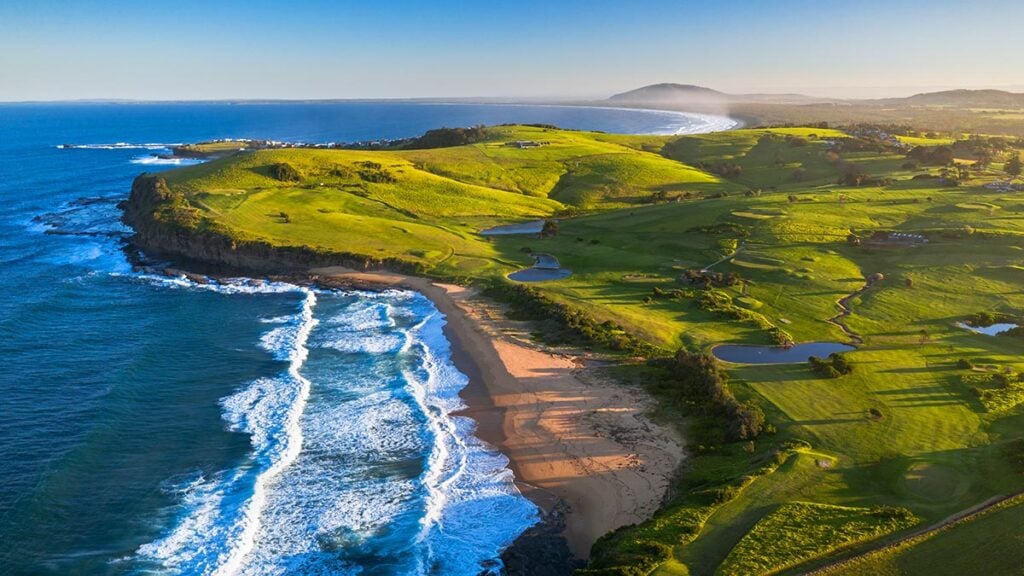The creation stories of Augusta National’s bunkers.
Of all the golf courses most known for their beauty, Augusta National is the most ephemeral. Merely to evoke the name is to conjure images of flawless green bursting through hues of bright pinks, reds, yellows, greens and whites, each fairway escorted by courtly arrangements of towering southern bloom.
It’s tempting to think this is the natural state of Augusta National, but the playing of the Masters – the only time 99.9 percent of us see the course – is timed to coincide with the seasonal outburst of its immense flora. The orchestration is overwhelming, but it comes and goes quickly, an early April Brigadoon that soon disappears from everything but the mind’s eye.
No other great course’s aesthetics are so fleetingly attached to reality as Augusta’s. If you play the course in November, February or late April as most members and guests do, its beauty is more monochromatic, the technicolour dreams dialled down to ordinary emerald hues. Or if you were to see it during the northern summer when the club is closed, brown.
One aesthetic that doesn’t phase in and out is Augusta National’s bunkers. Though it possesses fewer than most top-ranked courses, just 44, their presence is immense. They are the statues in the garden, their placement carefully considered and shapes exquisitely honed. The bright white, scalpel-edged bunkers are as much a part of our vision of the ideal Augusta National as the closely cropped turf, glassy blue ponds, skyscraper pines and kaleidoscope scenery.
While the founders always intended to show off the property’s wide range of trees, shrubs and flowering plants – Augusta National was previously a nursery and chairman Clifford Roberts eagerly embraced the existing botanicals as part of the club’s identity – the bunkers were not originally meant to be so perfect. Their journey towards statuesque status has been a long one.

1933-1946
Augusta’s original architect, Alister MacKenzie, believed that good design should strive to be indistinguishable from nature, and he intended for his courses to blend into their surroundings. This was easier done in the sand and dunes of links designs – or the dunes of Cypress Point, or the Sandbelt of Melbourne. The hard clay soils of Georgia, however, did not lend to the kind of eroded-edge bunker style that might seem indigenous in nature. Nevertheless, MacKenzie attempted to make his bunkers at Augusta National appear haphazard and not artificial, and he had them built with irregular lobes, tongues, capes and scribbled edges. They were also relatively shallow and flush to the grades beneath them since deeper bunkers in the poor-draining clay soils would quickly fill up with water during storms.
MacKenzie’s filigreed edging at Augusta National faded through the lean Depression years of the 1930s due to the economics of maintenance, course alterations and lack of his oversight (he died in 1934). Perry Maxwell, MacKenzie’s former partner who began making architectural changes in 1937 by building new greens and bunkers, was known for a naturalistic style of his own in original designs, but the new hazards he built at holes like seven, nine and 10 didn’t have the same ornate shapes and edging of MacKenzie’s.
Augusta National closed temporarily during World War II, and the Masters was suspended from 1943 through 1945. During this time the holes went fallow (the property was used to graze livestock as a revenue source), and when it reopened, considerable work was needed to repair the course. The details of whatever remained of MacKenzie’s bunker concepts were largely erased.

1947-1974
As the club resumed normal operations after the war, it hired Robert Trent Jones to modernise the course. Jones was known for building rugged, cloverleaf-shaped bunkers, but those he constructed or renovated at holes like holes one, 16 and 18 bore a more open-faced, utilitarian look common in the post-war era for their relative ease of maintenance.
Architect George Cobb became the club’s consulting architect in the 1950s and continued the pattern of enlarging, simplifying and shifting bunkers. Those behind the 13th green, for instance, became rounded and moved higher up the back hillside. He also filled in MacKenzie’s large, intricately shaped fairway bunker on the 14th hole and shifted another centerline cross-hazard on the par-5 eighth to the right side of the fairway. Later, in the 1960s, Cobb relocated the central bunker on the par-5 second hole to a position further down the fairway towards the outside corner of the dogleg.
During this era the bunker shapes settled into the formats we recognise today, though they retained a rough-around-the-edges appearance due to the use of riding mowers that stopped short of clipping the bunker perimeters. They were still, however, quite shallow due to drainage concerns and the type of coarse sand in use. By the late 1960s, mechanical hand-edgers became popular throughout the industry, and Augusta National was able to create defined lips around the bunkers. The side effect of using spinning metal blades to edge the bunkers was that slivers of earth were sometimes scalped away with each pass, and slowly the size of the bunkers grew as the lips incrementally widened.

1975-1981
One of the most impactful changes to the bunkers occurred before the 1975 Masters. For decades the sand had been off-white with coarse, rounded particles (probably locally sourced), and players frequently had to play explosion shots when balls cratered. Roberts noticed the sand at his home club in western North Carolina was different and discovered they were sourcing it from a nearby quarry. Roberts had the new, pearl-white sand trucked into Augusta National and installed in its bunkers prior to the 1975 tournament.
Called North Carolina Spruce Pine sand, it was made of quartz (igneous rather than from sedimentary rock) and had a finer, more angular structure. Not only was it a firmer and more consistent surface to play from (meaning better shot control), but the shape of the particles made it able to stand up vertically against the faces of the bunkers that had been getting gradually steeper and more upswept. Though significant work was required to push the sand back up the slopes when rain washed it out, the high, white oval faces nudging into the greens became entrenched as a defining aesthetic.

1982-1993
When Augusta National hired Billy Fuller to be the superintendent after the 1981 Masters, the club was not the turf and conditioning superpower it has become. The maintenance facilities and commitment to agronomic science was not much different than other clubs, but the ’80s marked a renaissance period of turf and conditioning, starting with Augusta National’s conversion of its greens from Bermuda grass overseeded with rye to firmer, faster bentgrass. After a misstart in 1981 Fuller was hired for the 1982 Masters, and several years later installed the first prototype hydronics system that could help control soil temperatures under the troublesome 12th green.
Drainage continued to be the bane of the bunkers, and each summer the sand had to be cored out and the drainage repaired. To avoid this costly expenditure, Fuller developed the first type of bunker-liner system. During the summer of 1982, he and his crew rebuilt every bunker on the course, lining each with two inches of gravel and covering that with a polymer membrane before replacing the sand. The system allowed water to pass through the sand and liner, then drain down behind the sand through the gravel. After rainstorms, 90 percent of the sand continued to adhere to the bunker face, eliminating the need to shovel it back up the slope or do annual repairs. Today, bunker-liner systems such as this, which later came to be called the Better Billy Bunkers, are standard throughout the industry.
The last new bunkers at Augusta National were also added during this time, in 1983, when consulting architect Jack Nicklaus suggested the fairway bunker left of the third fairway would be a more effective hazard if it were broken into a series of bunkers (there was even talk of adding a small pond in that location). The single existing bunker became four, and the number and style of the bunkers has not meaningfully changed since then.
1994-2025
The most notable work done at Augusta National during the mid-1990s was the continuing installation of more sub-surface heating and drainage systems under the greens, and the addition of the second cut of rough in 1999. The club made Tom Fazio its consulting architect, though aside from the continuing improvements in course-wide drainage and subtle alterations around the greens, no major architectural projects were undertaken until 2002. These included the “Tiger-proofing” of select holes through lengthening, and the subsequent addition of new pines on holes like 11, 15 and 17. The club has continued to lengthen holes where it can and occasionally institutes more substantial changes like the remodel of the 11th hole for the 2022 Masters.
During this time, the appearance, number and placement of Augusta National’s bunkers has been relatively consistent, the detailing of their shape and edging now dialed in. The last significant changes have been the shifting of several fairway bunkers: on the first and eighth holes in 2002, when both were moved 15 yards further down the fairway; at 18 where the two left-side bunkers were expanded during the 2011 lengthening; and at the par-4 fifth where the two inside left bunkers were made smaller, deeper and pulled slightly closer to the tee after the hole was lengthen by 40 yards.
It’s in these bunkers where Fazio’s group has slowly brought its own aesthetic to bear. Both the first and eighth fairway bunkers have been deepened and reshaped with a more curve-and-cape topline, not as ornate as MacKenzie’s bunker on 10 but with more unique character than most of the other bunkers at Augusta National.
The bunkers have come a long way from the scrapes and scabs that MacKenzie’s crews dug into the Georgia clay, but it’s important to note there was no unifying force guiding their changing forms. Through piecemeal remodelling by different architects, the passage of time and improvements in drainage, sand texture and other maintenance advances, they’ve evolved into an array of yawning shapes that take the form of oyster shells, bowls, deep amoebas and a few that make a faint nod to MacKenzie, though he might argue that notion.
It would be sacrilegious to alter this aesthetic now, one that’s been entrenched for more than 50 years, far longer than the look that existed when the course debuted in 1933. While the course blooms and recedes around them, the 44 white sculptural forms efficiently control the playing strategies and define how we think of Augusta National as much as any other element of the design. The bunkers might continue to shift and expand as needed, but their presence and presentation has, at last, moved from evolving to immutable.




